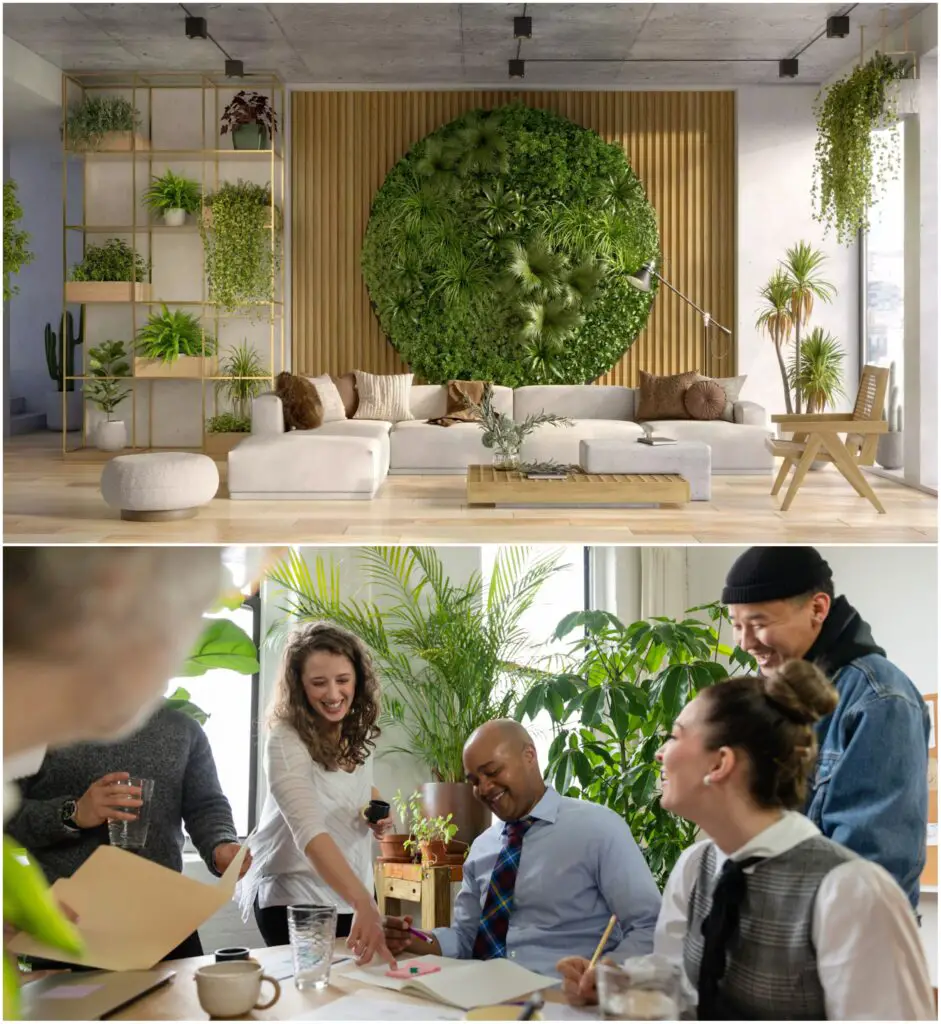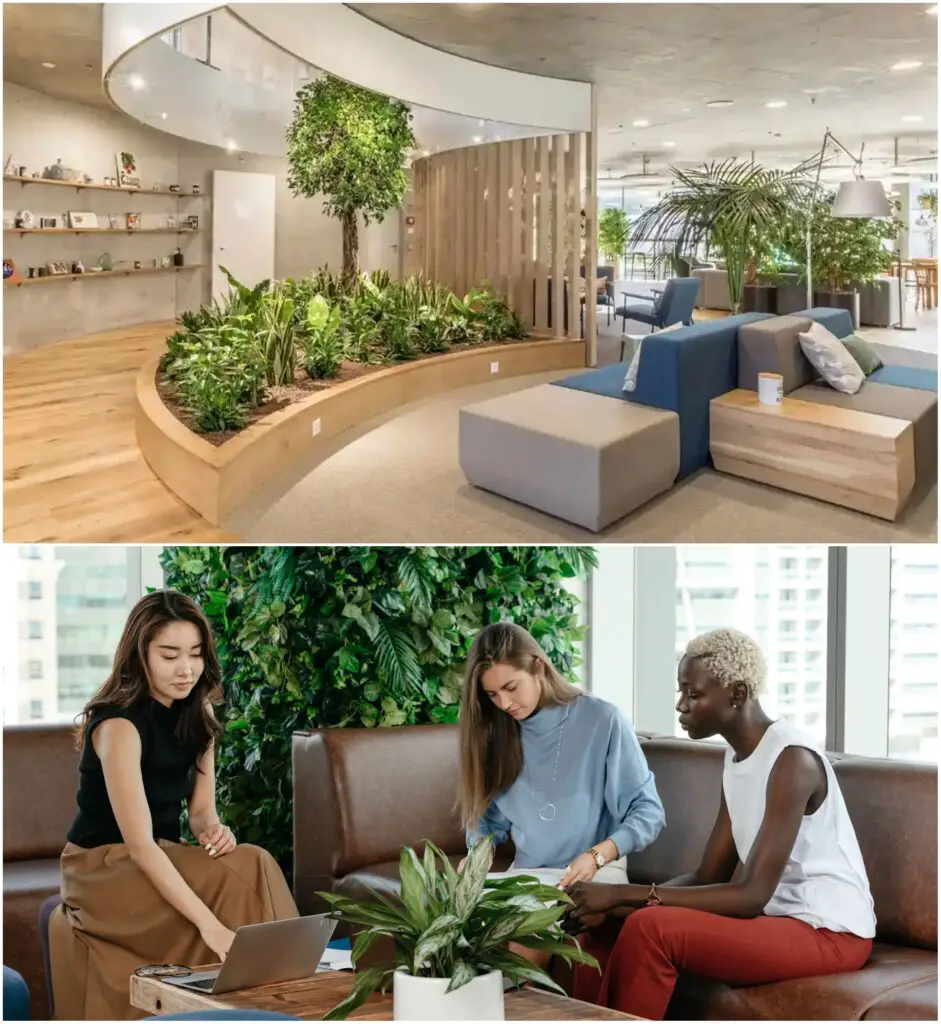As more Americans search for methods for improving their well-being at home and at work, biophilic design has grown in popularity in recent years.
Whether working from home or in an office setting, many Americans increasingly spend a significant amount of time indoors.
By including natural features like plants, natural light, and earthy materials, biophilic design helps create a relaxing impact that makes these places more refreshing and less stressful.
The wellness movement is one of the primary triggers of the development in biophilic design. Spaces that make people feel good in addition to looking nice are becoming more and more popular among Americans.
Many people are selecting furnishings that encourage relaxation, lower stress levels, and even boost attention as part of this health movement.
This may be accomplished by bringing nature indoors, which is why biophilic design is becoming more and more popular in homes, offices, and even educational institutions.

Biophilic Design
The Benefits of Biophilic Design
1. Enhanced Mental Health
- The impact of biophilic design on mental health is among its greatest advantages.
- According to studies, exposure to natural elements like sunlight and plants can elevate mood and lessen stress.
- Those who are surrounded by nature or décor with a natural theme report that the feeling happier and more at peace.
- Another study has shown that exposure to natural light and greenery may boost cognitive function, which includes memory, concentration, and problem-solving abilities.
2. Increased Productivity
- One reason biophilic design is becoming more and more popular in American workplaces is that it is also recognized to increase productivity.
- Natural light, plants, and vistas of the outdoors are examples of elements that improve concentration and encourage creativity.
- According to the Human Spaces research, workers who work in offices with natural features like sunlight and plants report feeling more productive and happier overall by 15%.
Because of these productivity advantages, biophilic design is particularly popular for modern office settings, where many businesses want to build settings that support innovation and employee involvement.
3. Physical Health Benefits
- Biophilic design may improve physical health in addition to mental well-being.
- By raising oxygen levels and eliminating some dangerous pollutants, indoor plants help in purifying the air.
- People feel less tired and more energized throughout the day as a result of the improved air quality.
- Some indoor plants may eliminate up to 87% of air pollutants in a day, according to NASA’s Clean Air Study.
Key Principles of Biophilic Design
By following to a few fundamental principles, biophilic design brings nature within and creates a peaceful, natural atmosphere in homes and offices.
These principles include making the most of natural light, including water, introducing vegetation, using natural materials, and providing views of the outdoors.
1. Natural Light
- One of the most important parts of biophilic design is natural light.
- You can make your interior rooms brighter and cozier by letting natural light in.
- Also, exposure to natural light enhances mood, lessens eye strain, and helps in sleep cycle regulation.
- Using light-colored window treatments, putting skylights if at all possible, and positioning furniture to keep windows unobstructed are all easy strategies to optimize natural light.
Read: How to Create a Zen Meditation Room in Your Home?

2. Indoor Greenery
- A key component of biophilic architecture is plants.
- Any indoor space is made more natural and fresh by the addition of greenery, whether it is in the form of hanging plants, potted plants, or even vertical gardens.
- In addition to being beautiful, plants increase humidity, clean the air, and boost general health.
- Vertical gardens are a popular option for people who want to make a large impression, especially in living rooms and offices where they may create a lush, green backdrop.
3. Natural Materials and Textures
- Natural elements like wood, stone, and organic textiles are preferred in biophilic design because they provide texture and warmth.
- A feeling of closeness to the soil is created by wood furniture or décor, stone accents, or textiles like cotton, linen, or wool.
- By using these materials, a place can feel more grounded and at ease.
- Adding natural elements indoors can be accomplished with small details like woven carpets, stone surfaces, or a wooden coffee table.
4. Water Elements
- Small water features can improve the calmness of an indoor area because water has a naturally calming impact.
- Fish tanks, indoor fountains, or even tabletop water features emit a soft sound that reduces tension and encourages relaxation.
- These characteristics can be especially calming in environments designed for relaxation, including living rooms or study areas.
5. Views of Nature
- Another useful biophilic design approach is to create views of nature even indoors.
- Skylights, large windows, or even just using mirrors to reflect the outside world can have a significant impact.
- In the absence of outdoor views, the effect can be duplicated with nature-inspired artwork, photographs, or landscape murals.
- The goal is to establish a visual link to nature that calms the mind and eases tension.
How to Incorporate Biophilic Design at Home?
There are simple, quick measures you can take to include biophilic design into your house.
You can design a room that feels revitalizing and connected to nature by stressing the addition of plants, maximizing natural light, using natural materials, developing a soothing color scheme, and including water and sound.
1. Start with Greenery
- An excellent place to start when designing biophilically is with indoor plants.
- They not only make any environment more beautiful, but they improve the air quality and give it a more organic sense.
- When picking indoor plants, look for easy-care varieties like peace lilies, pothos, or snake plants, which require little watering or sunlight.
- Consider adding hanging plants to create a lush, green look or arranging plants at different levels for added priority.
2. Enhance Natural Light
- A room is brightened and given a cozy, welcoming feel by natural light.
- Make sure your furniture is not blocking windows to maximize the amount of natural light in your house.
- To let sunlight in, you can also use sheer or light-colored drapes.
- Mirrors are another useful tool for spreading and reflecting natural light, which gives the space a lighter, airier feel.
3. Use Natural Materials
- Natural-material furnishings and décor give any space a grounded, earthy feel.
- To add warmth and texture, look for pieces composed of bamboo, rattan, or wood.
- A touch of nature can be included with wooden coffee tables, rattan chairs, and throws and cushions made of cotton or linen.
- Achieving a natural style can be influenced by even tiny objects, such as woven baskets or wooden photo frames.
4. Create a Nature-Inspired Color Palette
- For a color scheme inspired by nature, earth tones like greens, browns, and gentle blues are perfect. Like being outside, these colors produce a serene and soothing ambiance.
- For walls, furniture, or décor, think about utilizing beige, moss green, or sky blue hues.
- To create an environment that seems grounded and balanced, you can mix and combine these colors.
5. Include Water and Sound
- Adding water to your home can help create a soothing atmosphere because it has a calming influence by nature.
- The calming effects of water can be brought indoors with little tabletop fountains, fish tanks, or even recordings of natural sounds.
- The soft sound of running water from a tiny fountain placed in a living room or bedroom can help calm people and create a sense of peace.
Read: Interior Design for Renters – Making the Most of a Temporary Space

Why Offices are Adopting Biophilic Design?
Biophilic design is becoming more and more popular in offices since it has a direct effect on worker satisfaction and productivity.
Open areas, plants, and natural light all contribute to a happier, more focused, and less stressful environment.
Employees are more likely to feel motivated, creative, and engaged at work when they are surrounded by décor with a natural theme.
A study by the Human Spaces report found that workers who work in natural settings report better concentration, fewer health issues, and a 15% higher sense of well-being.
Because of these advantages, biophilic design is a desirable choice for companies trying to make their workplaces healthier and more efficient.
Strategies for Biophilic Workspaces
1. Living Walls
- A beautiful approach to add greenery to improve the quality of the air is with living walls or vertical gardens.
- Installing these walls in conference rooms, lobbies, or even workplace halls can increase productivity while creating a lively, green environment.
2. Communal Plants
- Adding plants to common spaces like kitchens, lounges, or conference rooms makes them feel more comfortable and welcome.
- To bring nature into common areas, plants might be arranged on windowsills, tables, or shelves.
3. Breakout Zones
- Another important tactic is to designate areas where staff members can rest and recharge.
- These areas can have cozy chairs, windows, and vegetation, giving staff members a place to rest and rejuvenate.
- These spaces promote creativity and social interaction, which can improve teamwork and morale.
How Renters Can Use Natural Elements Without Permanent Changes?
By highlighting features that do not involve drilling holes or making permanent adjustments, renters can create an ambiance that is influenced by nature.
In this case you can,
- To increase light and strengthen the connection to the outside, use detachable window treatments like bamboo blinds or sheer curtains.
- Use throw pillows, floor rugs, and bed linens composed of cotton, linen, and wool to add organic textures.
- Hang photos or prints of landscapes, plants, or animals that reflect the serene serenity of the natural world to incorporate nature-inspired art.
- To add greenery without heavy installations or wall-mounted planters, use floor plants.
Renters can take benefit of the biophilic design while still honoring the restrictions of their rental space with these simple, detachable options.
These minor, well-considered adjustments can have a significant impact on the creation of a peaceful natural house.

Bottom Line
Without a doubt, as biophilic design develops further, it will influence how we live and work by creating more livable, lively, and environmentally conscious houses and workplaces. So why not make the initial move now? Learn how making minor biophilic adjustments can improve your life and see the benefits for yourself.











